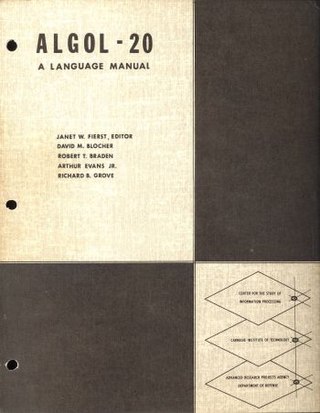Related Research Articles

ALGOL is a family of imperative computer programming languages originally developed in 1958. ALGOL heavily influenced many other languages and was the standard method for algorithm description used by the Association for Computing Machinery (ACM) in textbooks and academic sources for more than thirty years.

Simula is the name of two simulation programming languages, Simula I and Simula 67, developed in the 1960s at the Norwegian Computing Center in Oslo, by Ole-Johan Dahl and Kristen Nygaard. Syntactically, it is an approximate superset of ALGOL 60, and was also influenced by the design of Simscript.
Pretty-printing is the application of any of various stylistic formatting conventions to text files, such as source code, markup, and similar kinds of content. These formatting conventions may entail adhering to an indentation style, using different color and typeface to highlight syntactic elements of source code, or adjusting size, to make the content easier for people to read, and understand. Pretty-printers for source code are sometimes called code formatters or beautifiers.
ALGOL 60 is a member of the ALGOL family of computer programming languages. It followed on from ALGOL 58 which had introduced code blocks and the begin and end pairs for delimiting them, representing a key advance in the rise of structured programming. ALGOL 60 was one of the first languages implementing function definitions. ALGOL 60 function definitions could be nested within one another, with lexical scope. It gave rise to many other languages, including CPL, PL/I, Simula, BCPL, B, Pascal, and C. Practically every computer of the era had a systems programming language based on ALGOL 60 concepts.

ALGOL 68 is an imperative programming language that was conceived as a successor to the ALGOL 60 programming language, designed with the goal of a much wider scope of application and more rigorously defined syntax and semantics.
In computer programming, a statement is a syntactic unit of an imperative programming language that expresses some action to be carried out. A program written in such a language is formed by a sequence of one or more statements. A statement may have internal components.
ALGOL 58, originally named IAL, is one of the family of ALGOL computer programming languages. It was an early compromise design soon superseded by ALGOL 60. According to John Backus
The Zurich ACM-GAMM Conference had two principal motives in proposing the IAL: (a) To provide a means of communicating numerical methods and other procedures between people, and (b) To provide a means of realizing a stated process on a variety of machines...

Nobuo Yoneda was a Japanese mathematician and computer scientist.
Jensen's device is a computer programming technique that exploits call by name. It was devised by Danish computer scientist Jørn Jensen, who worked with Peter Naur at Regnecentralen. They worked on the GIER ALGOL compiler, one of the earliest correct implementations of ALGOL 60. ALGOL 60 used call by name. During his Turing Award speech, Naur mentions his work with Jensen on GIER ALGOL.

Transcription regulator protein BACH1 is a protein that in humans is encoded by the BACH1 gene.

Transcription regulator protein BACH2 is a protein that in humans is encoded by the BACH2 gene. It contains a BTB/POZ domain at its N-terminus which forms a disulphide-linked dimer and a bZip_Maf domain at the C-terminus.
Dartmouth ALGOL 30 was a 1960s-era implementation, first of the ALGOL 58 programming language and then of ALGOL 60. It is named after the computer on which it ran: a Librascope General Precision (LGP-30) desk-size computer acquired by Dartmouth College in 1959.
Eiiti Wada is a computer scientist and emeritus professor at the University of Tokyo and the Research Director of Internet Initiative Japan (IIJ), a computer network technology company. He is one of the creators of the Happy Hacking Keyboard.
IFIP Working Group 2.1 on Algorithmic Languages and Calculi is a working group of the International Federation for Information Processing (IFIP).

Hiizu Iwamura is a Japanese chemist and Professor of Chemistry, Nihon University, as well as Professor Emeriti of the Institute for Molecular Science in Okazaki, the University of Tokyo, and Kyushu University in Japan.

Omidenepag, sold under the brand name Eybelis among others, is a medication used for the treatment of glaucoma and ocular hypertension.
References
- ↑ Igarashi, S.; Iwamura, T.; Sakuma, K.; Simauti, T.; Simuzu, T.; Takasu, S.; Wada, E.; Yoneda, N. (February 1969). "ALGOL N". ALGOL Bulletin (30): 38–85.
- ↑ Igarashi, S.; Iwamura, T.; Sakuma, K.; Shimauti, T.; Shimizu, T.; Takasu, S.; Wada, E.; Yoneda, N. (February 1969). Study of an Algorithmic Language: The Description and Compiling: ALGOL N (PDF). Kyoto University Research Information Repository (Report).